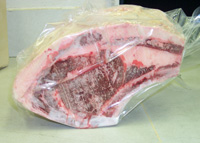Meats Research Helps Processors Take Food Safety to Higher Level
Meats Research Helps Processors Take Food Safety to Higher Level

At the University of Kentucky College of Agriculture food scientists are subjecting hamburgers, steaks and entire sides of beef to acids, flame, steam and ultra-cold temperatures to make these already safe products even safer.
The idea behind these experiments is to reduce normally occurring bacteria counts on meats to even lower levels.
“Every fresh food product has some level of bacteria on it which is usually harmless, but disease-causing pathogens also can be present and so if you reduce the bacteria count you increase the safety of an already safe product,” said Melissa Newman, meats researcher in the UK College of Agriculture. “We refer to it as hurdle technology because the more hurdles you throw at bacteria the more likely the product is going to be safe.”
Newman and Benjy Mikel, Extension meats specialist, are using a variety of techniques to see which one is most effective at reducing microorganisms.
“By using any number of decontamination methods, such as organic acids, quick chilling, flame or steam, you can slow down or kill bacteria in the lower value cuts that typically go into ground beef products,” Mikel said. “We’re also looking at which methods are most effective at removing bacteria from a beef carcass before it's cut up, and of course that would increase safety for the high value cuts as well as lower value cuts.”
The various methods, which are relatively inexpensive, are designed to be practical and usable for smaller-sized meat processing operations.
“These smaller processors wouldn’t have to buy a big, expensive piece of equipment or a lot of chemicals to do this,” Newman said.
In a typical on-site application an employee might be assigned to apply the flame or steam. If the meat were an entire carcass, it probably would pass through some type of chamber while the decontamination was applied.
“As we determine the best treatment or methods we make that information available to our processors,” said Mikel, who noted these methods do not affect the food’s taste.
In addition to increased food safety, the decontamination methods also have the potential of making refrigerated meats last longer.
“Some bacteria contribute to a shorter product shelf life, so if you can include a step in the processing where you reduce or eliminate bacteria by the time it gets to the consumer it could stay fresh longer with proper refrigeration,” Newman said.
By determining which decontamination methods work best, the UK researchers hope to add value to beef products and benefit meat processors, retailers and consumers.